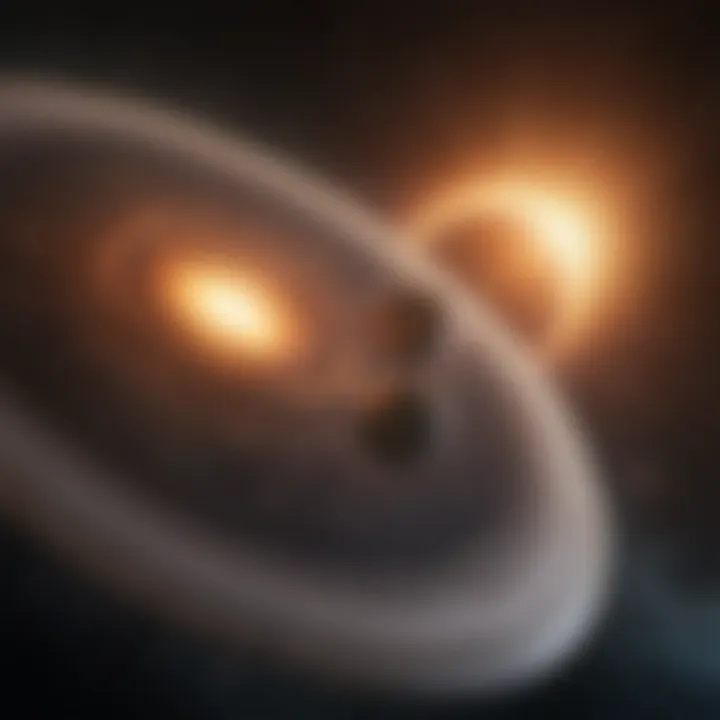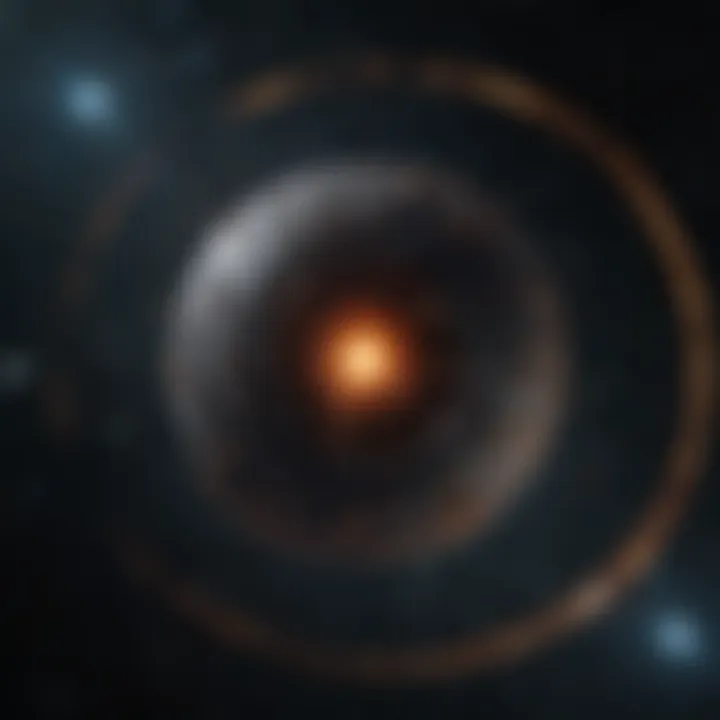Exploring the Cosmos: Current Trends in Space Science


Intro
The vastness of space has always been a source of intrigue and inspiration for humanity. As modern technology advances, our understanding of the cosmos also expands. Current research aims to unravel the mysteries of the universe, shedding light on fundamental questions of existence, the formation of celestial bodies, and the nature of dark matter and energy. This article offers a detailed exploration of contemporary space research, focusing on key breakthroughs in various fields such as astrophysics, planetary science, and space technology.
Engagement with this topic is essential for students, researchers, and educators alike, as it underscores the need for scientific literacy. Understanding current developments in space research fosters an informed populace capable of critically evaluating scientific claims. This guide aims to present complex subjects in a manner that is both accessible and informative, making intricate scientific endeavors comprehensible.
Research Overview
Summary of Key Findings
Ongoing research in space science has yielded significant findings that enhance our knowledge of the universe. One major breakthrough includes the detection of gravitational waves, which confirms key aspects of Einstein's theory of General Relativity. Moreover, the discovery of exoplanets using the transit method has opened new avenues in the search for habitable worlds beyond our solar system.
In planetary science, missions like NASA’s Perseverance rover have provided insights into the Martian surface and its past potential for life. These findings contribute to a deeper understanding of planetary formation and evolution.
Importance of the Research in Its Respective Field
The implications of these research breakthroughs are profound. Understanding gravitational waves leads to advancements in astrophysics and the study of cosmology. Knowledge about exoplanets aids in identifying locations that may sustain life, thereby addressing fundamental questions about our place in the universe. Research in planetary science informs not only our knowledge of Mars and other celestial bodies but also enhances our understanding of Earth's own geological history.
"The exploration of the universe is not just a scientific endeavor; it represents humanity’s quest for knowledge and understanding of our origins and existence."
Methodology
Description of the Experimental or Analytical Methods Used
Research in space science employs a diverse array of methods. For instance, gravitational wave detection utilizes laser interferometry. Instruments like LIGO (Laser Interferometer Gravitational-Wave Observatory) measure minute distortions in space-time. Similarly, the transit method for exoplanet detection relies on monitoring the brightness of stars over time, looking for periodic dimming, which indicates a planet passing in front of a star.
Sampling Criteria and Data Collection Techniques
Data collection in astrophysics often involves telescopes and satellite missions. Advanced observatories such as the James Webb Space Telescope are designed for sensitivity to a wide range of wavelengths. In planetary science, rover missions conduct in-situ analysis of soil and rock samples, utilizing spectrometers to study composition and structure.
This approach allows researchers to gather concrete data, providing a reliable basis for further theoretical exploration. As the methodologies in space research evolve, our ability to comprehend complexities of the universe also increases.
Preface to Space Science
The study of space science is paramount in our quest to understand the cosmos. This field encompasses various disciplines such as astrophysics, planetary science, and cosmology. Each of these areas plays a vital role in revealing the mysteries of the universe. By examining celestial objects, exploring planetary systems, and studying the evolution of cosmic structures, researchers gather insights essential for further scientific advancements.
Space science not only satiates human curiosity but also possesses practical implications. Understanding phenomena such as space weather can influence satellite communications and navigational systems on Earth. Additionally, knowledge of other celestial bodies informs potential resources and habitats for future human exploration. With the current advancements in technology, studying space has become increasingly accessible, allowing scientists to expand their horizons.
Defining Space Science
Space science refers to the study of celestial entities and the underlying physical processes occurring in the universe. This broad field integrates knowledge from multiple scientific areas, including physics, chemistry, and geology. It focuses on analyzing the cosmos through observation, experimentation, and theoretical modeling. Consequently, space science is one of the key foundations supporting modern astronomy and astrophysical research.
In practice, space science covers a multitude of topics. These range from the analysis of cosmic radiation and gravitational waves to the exploration of exoplanets and the dynamics of solar systems. Researchers utilize advanced observational techniques and sophisticated instruments, such as telescopes and satellites, to gather data and develop models explaining celestial phenomena.
Historical Context
The history of space science is rich and marked by remarkable milestones. It began centuries ago with early astronomers who meticulously recorded observations of celestial objects. The invention of the telescope in the 17th century revolutionized astronomy by enabling deeper investigations into the night sky. Pioneers like Galileo Galilei expanded our understanding of planets and moons, laying critical groundwork for future advancements.
The 20th century brought another leap forward with the advent of space exploration. The launch of Sputnik 1 by the Soviet Union in 1957 marked the beginning of the space age. This event ignited global interest in space science, leading to numerous missions and research initiatives. The Apollo program highlighted human capability in extraterrestrial exploration, culminating in the momentous Moon landings.
As technology progressed, so did the complexity of space missions. Contemporary space agencies, such as NASA and ESA, conduct extensive research missions, often collaborating internationally. Programs focused on Mars exploration, satellite deployment, and deep-space observation continue to enhance our grasp of space science. Engaging with this rich history is essential for appreciating the evolution of our understanding and the ongoing discoveries that shape the future of this field.
Astrophysics: The Science of the Universe
Astrophysics plays a critical role in understanding not just the universe, but also the fundamental laws that govern it. This branch of astronomy merges the principles of physics and astronomy to explore celestial phenomena. It seeks to unravel mysteries of cosmic origins, structure, evolution, and ultimate fate. Astrophysics helps to address pressing questions about how the universe works and our place within it.
Fundamental Concepts
Understanding astrophysics requires a solid grasp of its fundamental concepts, including gravity, light, and cosmic evolution. Gravity dictates the movement of planets, stars, and galaxies. The behavior of light reveals critical information about these entities. Tools such as spectroscopy and photometry help astrophysicists parse data collected from telescopes. Knowledge of these elements is essential as they form the framework upon which advanced theories are constructed.
Theoretical Models
Big Bang Theory
The Big Bang Theory is a cornerstone in the field of astrophysics. This model describes the universe's origin roughly 13.8 billion years ago from an extremely hot and dense state. Its key characteristic is the expansion of space, which aligns with observational evidence such as redshifted galaxies. This theory is a beneficial inclusion for this article because it forms the basis of understanding cosmic evolution. A unique feature of the Big Bang Theory is the cosmic microwave background radiation, which serves as a remnant echo of this expansion. However, it has limitations, particularly in addressing what came before the Big Bang.
Cosmic Inflation
Cosmic Inflation expands upon the Big Bang Theory, suggesting that the universe underwent an exponential expansion a fraction of a second after the Big Bang. Its key characteristic is the rapid stretching of space, which accounts for the uniformity of the cosmos. This theory is relevant in this article as it helps explain the large-scale structure we observe today. One of the unique features of Cosmic Inflation is that it solves several puzzles of the Big Bang model. Despite its compelling aspects, it requires fine-tuning, which can complicate its acceptance among some researchers.
Emerging Discoveries


Gravitational Waves
Gravitational waves are ripples in spacetime caused by violent astrophysical events, such as merging black holes. Their detection has opened a new window into observing the universe, contributing immensely to our understanding of cosmic events and phenomena. A key characteristic of gravitational waves is their ability to provide information about events that are otherwise undetectable. This discovery is significant for the article as it represents a new means to probe the extremes of physics. The unique feature is that they offer a different perspective on traditional electromagnetic observations. Nonetheless, the technology required to detect them is costly and complex, presenting challenges for broader future investigations.
Dark Matter
Dark matter is a mysterious component of the universe, constituting about 27% of its total mass-energy content. It does not emit, absorb, or reflect light, making it invisible to conventional instruments. Its significance lies in its gravitational effects on ordinary matter, influencing galaxy formation and motion. Dark matter is an essential topic for this article, as it highlights the unseen factors that shape our universe. The unique feature of dark matter is its ability to connect disparate astronomical observations into a cohesive narrative. However, its elusive nature raises questions regarding its true composition, complicating the drive toward a fuller understanding.
Planetary Science: Understanding Other Worlds
Planetary science plays a crucial role in our understanding of the universe. It examines the complexities of other celestial bodies and their processes. Knowledge of planetary systems allows us to make inferences about Earth’s own geological history. This branch of science also contributes to our exploration and potential colonization of other planets.
Planetary Formation Theories
Understanding how planets form helps us grasp the evolution of our solar system and beyond. Theories such as the nebular hypothesis explain that planets form from the leftover gas and dust surrounding new stars. This process creates a wide variety of planetary bodies, each with unique characteristics. Insights into planetary formation can also inform us about the conditions necessary for life elsewhere.
Geological Activity on Other Planets
Investigating geological activity reveals the dynamic nature of other worlds. This analysis allows us to compare different planetary environments and understand their histories. There are two key areas to focus on:
Volcanoes on Mars
Volcanic activity on Mars offers valuable information about the planet's past. The Tharsis volcanic region is characterized by massive shield volcanoes like Olympus Mons, which is approximately 13 miles high. This unique feature signifies a long history of volcanic activity, showing that Mars was once geologically active. Understanding Martian volcanism helps researchers draw conclusions about the planet’s atmosphere and potential habitability.
Advantages of studying volcanoes on Mars include:
- Insights into volcanic processes that shaped its surface.
- Evidence of previous water flows tied to volcanic heat.
However, disadvantages include the challenge of accessing and analyzing remote regions.
Tectonics on Venus
Tectonic processes on Venus provide a stark contrast to Earth’s tectonic behavior. Unlike Earth, where plate tectonics is active, Venus shows a different pattern. Its surface is mostly stable but shows signs of deformation. Features like fractured terrain highlight that tectonic activity has occurred, albeit differently.
The key characteristic of tectonics on Venus is its volcanic resurfacing, allowing for a young geological age despite its ancient atmosphere. This makes it a beneficial choice for understanding planetary evolution.
The unique feature of Venusian tectonics is the lack of water, which directly impacts geological processes. This contributes to its thick atmosphere and extreme temperatures, creating conditions vastly different from those on Earth.
Habitability and Astrobiology
Assessing habitability increases our comprehension of life beyond Earth. Mars continues to be a focus alongside other celestial bodies.
Potential of Mars
Mars has garnered attention for its potential to support life. Ongoing research discovers signs of past water sources, essential for life. Features such as river valleys and lake beds provide evidence of a wetter climate in its history. The key characteristic of Mars is the presence of ice at the poles and possibly subsurface lakes, making it a popular choice for astrobiological studies.
The unique feature of Mars is that it has conditions that might allow for future human habitation. This raises questions about the planet’s capacity to host life forms in the past and present.
Moons of Jupiter and Saturn
The examination of moons like Europa and Titan has led to exciting discoveries. These moons possess environments that could sustain life, primarily due to their subsurface oceans.
Key characteristics of these moons include their potential for chemical compounds necessary for life's creation. Thus, they are beneficial choices in astrobiological exploration.
The unique feature of these moons is their thick ice crusts believed to cover vast saline oceans. This deep oceanic layer can create conditions similar to those found on Earth, increasing the possibility of extraterrestrial life.
Understanding planetary science is not only about knowing the environments but also about comprehending the evolution of planetary systems and their potential impact on humanity's future.
The Role of Space Technology
Space technology serves as the backbone of all contemporary space research initiatives. It is the means through which we explore, observe, and interact with the universe beyond our planet. This area of research encompasses a wide range of technical developments, each playing a crucial role in enhancing our understanding of space phenomena. The evolution of technologies has enabled scientists to push the boundaries of our capabilities, making it possible to conduct complex missions that were previously deemed unimaginable.
The benefits of advanced technologies in space research are significant. These developments enhance our observational capabilities, provide safer and more efficient methods for human spaceflight, and empower scientists to gather data essential for understanding cosmic events. However, it is also essential to remain mindful of the challenges these technologies introduce, including maintaining operational integrity and managing costs. As we delve into specific aspects of space technology, we see how each contributes to the overall goals of space exploration and research.
Satellite Development and Applications
Satellites have revolutionized our ability to collect data and communicate across vast distances. Modern satellites are equipped with advanced instruments that facilitate Earth observation, weather forecasting, and communication. These instruments allow scientists to monitor climate change, study natural disasters, and track environmental changes on our planet.
Moreover, satellites play an integral role in astronomical research. They capture data from various celestial bodies, providing insights that were once unattainable. For instance, space telescopes like the Hubble allow us to observe distant galaxies and stars, revealing the universe's structure and history.
Advancements in Propulsion Systems


Ion Thrusters
Ion thrusters represent a significant advancement in propulsion technology, providing a more efficient alternative to traditional rocket engines. These systems operate by ionizing a propellant, typically xenon, and using electric fields to accelerate the ions, generating thrust. The key characteristic of ion thrusters is their high specific impulse, which translates to greater efficiency in propelling spacecraft over long distances.
One benefit of ion thrusters is their relatively low fuel consumption, allowing spacecraft to travel further without resupplying. However, a unique feature is the long operational time required to build thrust, making them less suitable for rapid maneuvers. In the context of space exploration, they offer a viable option for deep-space missions where fuel efficiency is paramount.
Nuclear Thermal Propulsion
Nuclear thermal propulsion serves as another revolutionary method in spacecraft propulsion. This system uses a nuclear reactor to heat a propellant, typically hydrogen, before expelling it through a nozzle. The primary advantage of nuclear thermal propulsion stems from its potential for high thrust-to-weight ratios and efficiency.
The unique feature of this technology lies in its scalability, allowing it to support crewed missions to destinations such as Mars and beyond. However, nuclear propulsion systems must also address safety and regulatory concerns, given the complexities associated with nuclear technology. This duality emphasizes the importance of thorough research into nuclear methods to unlock their full potential in space exploration.
Space Exploration Missions
Space exploration missions embody the practical application of space technology and scientific research. They serve as a platform for practical testing of theories and the gathering of invaluable data to enhance our understanding of space phenomena.
NASA's Artemis Program
NASA's Artemis Program aims to return humans to the Moon and lay the groundwork for future Mars missions. This program is notable for its emphasis on sustainable exploration. By focusing on establishing a permanent presence on the Moon, NASA plans to test technologies and operational concepts that will benefit upcoming interplanetary missions.
A distinctive aspect of the Artemis Program is its commitment to international collaboration and partnerships with private entities. This cooperative approach enhances resource sharing and accelerates technological advancements, although it also introduces complexities of coordination among diverse stakeholders.
ESA's Mars Sample Return
The European Space Agency's Mars Sample Return mission is poised to revolutionize our understanding of the Martian environment. It aims to gather soil and rock samples from the surface and return them to Earth for detailed analysis. This mission is critical as it seeks to answer fundamental questions about Mars’ potential for past life and its geological history.
The unique feature of this mission is its multi-phase approach that involves bringing together rover technology and launch systems to achieve a comprehensive scientific objective. However, the execution of such a complicated mission faces challenges, including the technical hurdles inherent in sample retrieval and transport across interplanetary distances.
"The exploration of outer space is a testament to human curiosity and innovation, helping us understand not only our place in the cosmos but also the origins of life and our planetary environment."
As we continue to advance space technology, we must remain aware of the implications these breakthroughs have on our exploration and understanding of the universe. Each technology carries its prospects and challenges, shaping the future of space research in profound ways.
Cosmology: Understanding the Structure of the Universe
Cosmology plays a crucial role in our understanding of the universe. It focuses on the nature and origins of the cosmos and examines the universe's evolution, structure, and eventual fate. Understanding cosmology provides insights into several fundamental questions about existence itself. This section highlights essential concepts, theories, and phenomena that underpin contemporary cosmological studies.
The Cosmic Microwave Background
The Cosmic Microwave Background (CMB) is a significant area of study in cosmology. This faint glow left over from the Big Bang provides a snapshot of the early universe, roughly 380,000 years after its formation. Its uniformity in all directions demonstrates how the universe has expanded over time.
Studying the CMB allows researchers to refine models of the universe's early conditions, thereby supporting theoretical frameworks. Key details about temperature fluctuations in the CMB offer clues about the distribution of matter and energy in the universe, influencing our understanding of dark matter and energy. Insights from the CMB have also provided evidence for cosmic inflation and helped to delineate the universe's geometric properties.
Cosmological Models
Lambda-CDM Model
The Lambda-CDM model is often viewed as the standard model of cosmology today. It incorporates concepts of dark energy, represented by the cosmological constant Lambda (Λ), alongside cold dark matter (CDM). This framework has become popular due to its ability to explain a wide array of observational data, including the CMB.
One key characteristic of the Lambda-CDM model is that it postulates an accelerated expansion of the universe. This is beneficial as it aligns with numerous astrophysical observations regarding the distant universe's structure and behavior. A unique feature includes its predictive power regarding the distribution of galaxies. However, it does have limitations, such as confronting challenges regarding the nature of dark matter and energy.
"Lambda-CDM provides a systematic approach for interpreting the universe's vast complexities."
Alternative Theories
While Lambda-CDM has gained prominence, multiple alternative theories exist and contribute to ongoing debates within cosmology. These theories often challenge established norms, encouraging deeper research into the universe's origins and fate. Examples include models incorporating modified gravity, which propose different explanations for observed cosmic phenomena.
A critical aspect of alternative theories is their ability to provide frameworks that some data may favor over Lambda-CDM. They often highlight key characteristics such as the adjustments in gravitational dynamics or different interpretations of dark energy. Such diversity is beneficial as it stimulates scientific discourse and exploration. However, these theories may lack the robust predictive power that Lambda-CDM exhibits across numerous cosmological observations.
In summary, cosmology encompasses complex content that influences many dimensions of modern science by revealing the universe's structure and dynamics. As new data emerges, our understanding of these models will continue to evolve, steering future research endeavors.
Space Weather and Its Implications
Space weather refers to the environmental conditions in space as influenced by solar wind and solar activities. It holds significant importance in understanding how these factors can affect not only space exploration but also technology and life on Earth. In this section, we will explore the various elements of space weather and its implications, including solar activity and its potential consequences on Earth. Understanding this topic is crucial in today's technology-dependent world, where disruptions caused by space weather can have widespread ramifications.
Solar Activity
Solar activity encompasses several phenomena resulting from cycles in solar radiation and magnetic fields. It includes sunspots, solar flares, and coronal mass ejections (CMEs). Each of these elements contributes to the overall dynamics of space weather.
Sunspots are areas on the Sun that appear dark because they are cooler than their surroundings. They are indicators of solar activity levels. Increased sunspot activity can lead to more solar flares and CMEs. Solar flares are intense bursts of radiation that can release substantial amounts of energy into space. Coronal mass ejections are significant expulsions of plasma and magnetic fields from the sun's corona. These two occurrences can directly influence space weather, affecting satellite operations and communications on Earth.
The study of solar activity is important because it provides insight into the Sun's behavior and helps predict future events. Accurate forecasting can mitigate the potential impacts on satellite technology, power grid systems, and even human health during space excursions.


Impact on Earth
Understanding the impact of space weather on Earth is essential for developing strategies to protect our technology and society.
Geomagnetic Storms
Geomagnetic storms are disturbances in the Earth's magnetosphere caused by solar winds and solar flares. These storms are characterized by their ability to disrupt communication systems, navigation technologies, and power grids. They occur when the solar wind interacts with Earth's magnetic field, leading to a day known as geomagnetic storm.
One key characteristic of geomagnetic storms is their variability in intensity and duration. Depending on the solar activity, a geomagnetic storm can range from moderate to severe. This variability is beneficial in terms of research as it provides a spectrum of data to study the underlying mechanisms and potential impacts of these storms. However, it also means that preparedness must be adaptive and well-planned.
The unique feature of geomagnetic storms is their ability to induce electric currents in power lines. These currents can lead to equipment damage, posing risks to the infrastructure that modern life relies upon. Understanding geomagnetic storms allows for improved protection against these risks, making it a critical aspect of space weather research.
Radiation Events
Radiation events, often associated with solar flares, are significant bursts of radiation that can reach Earth within minutes. Such events can potentially threaten astronauts on space missions and affect air travel routes.
A key characteristic of radiation events is the speed at which they occur. They can cause immediate effects on the Earth's atmosphere, affecting satellite operations and, in turn, communication and navigation signals. These events highlight the importance of continuous monitoring of solar activity.
The unique aspect of radiation events is their unpredictable nature. They can sometimes occur with little to no warning, presenting challenges for preparedness. However, advancements in monitoring technologies have improved our ability to forecast these events. This is an essential advantage for the safety of astronauts and in maintaining the integrity of space missions.
"Understanding space weather is not merely an academic exercise; it is vital for protecting our technology and ensuring the safety of human endeavors in space."
In summary, the influence of solar activity and its resulting phenomena have profound implications on Earth. As society becomes increasingly reliant on technology, the significance of understanding space weather will only grow, necessitating ongoing research and innovation in this field.
The Future of Space Research
Space research is on the brink of a transformative era. With advancements in technology and evolving scientific understanding, the future presents an array of opportunities for exploration and discovery. This evolution is driven not only by government agencies but also by private enterprises that seek to innovate and expand humanity's reach into the cosmos.
The significance of commercial space exploration cannot be overstated. It alters the dynamics of traditional space programs, allowing for faster and often more cost-effective missions. Furthermore, this shift promotes a competitive environment where new ideas can flourish. The implications of such developments are vast, promising a more inclusive approach to space travel that may soon see regular citizens venturing beyond Earth.
Commercial Space Exploration
Commercial space exploration refers to private companies engaging in activities previously dominated by government organizations. Companies like SpaceX and Blue Origin are at the forefront. Their successes in launching payloads and crewed missions illustrate the potential of privatized ventures in making space more accessible.
This model of operation encourages innovation. When different stakeholders contribute resources and expertise, there is a higher likelihood of breakthroughs. The race to establish bases on the Moon or Mars has inspired many companies to develop quicker and more efficient space technologies.
However, commercialization also brings challenges. Issues like regulation and environmental impact must be addressed. Balancing profit motives with ethical considerations is essential to sustainable progress.
International Collaboration in Space Science
International collaboration is crucial for advancing space research. Countries recognize that shared knowledge helps overcome the technical and financial barriers associated with space exploration. When various nations work together, they blend resources and unique expertise, paving the way for significant scientific achievements.
International Space Station
The International Space Station (ISS) represents a pinnacle of international collaboration. It serves as a microgravity laboratory for scientific research, welcoming scientists from diverse nations. The ISS is an example of what can be achieved when countries unite in pursuit of knowledge. Its multi-national team exemplifies the spirit of cooperation in space.
One key characteristic of the ISS is its modular structure, allowing for continuous upgrades and new experiments. This adaptability enhances its utility for ongoing research efforts, providing an invaluable platform for studying the effects of long-duration spaceflight on humans and other biological systems. Despite challenges such as funding and maintenance, the ISS remains a cornerstone of modern space exploration.
Global Research Initiatives
Global research initiatives aim to integrate knowledge from across the globe, focusing on pressing issues related to space science. Programs like the 100 Year Starship initiative emphasize the collaborative exploration of deep space and the long-term vision of interstellar travel. Such initiatives highlight the necessity of uniting global efforts to solve complex problems in space exploration.
The key feature of these initiatives includes their focus on sustainability. They strive not only for advancements in technology but also for the responsible use of resources to ensure that space exploration benefits future generations. Nevertheless, these collaborations face hurdles, including differing national policies and funding limitations.
Collaboration in space research signifies a collective acknowledgment of Earth's shared challenges. Every success reinforces the importance of unity in solving complex problems that extend beyond national borders. As we look forward, the synergy between commercial and international efforts is anticipated to drive space exploration into a new golden age of discovery.
Epilogue
In closing, this article has traced the intricate pathways of modern space research. It has explored the multifaceted disciplines within space science, detailing the rich findings in fields like astrophysics, planetary science, and space technology. The insights gleaned here underscore the profound implications of our current understanding of the universe.
Recap of Key Concepts
The discussion has revolved around several core principles. Firstly, we delved into the fundamental theories of astrophysics, such as the Big Bang and cosmic inflation, illustrating how these concepts frame our comprehension of the universe’s origin and expansion. Moreover, planetary science has elucidated various geological activities occurring on other worlds, providing critical knowledge about their potential for life. The advancement in space technology has also been significant. Programs such as NASA's Artemis and ESA's Mars Sample Return embody new achievements in exploration and understanding.
- Astrophysics has revealed key elements of the cosmic structure.
- Planetary science has broadened our perspective on habitability beyond Earth.
- Space technology advances have opened new frontiers for human exploration.
Each of these areas highlights the interconnectedness of research and technological development, revealing how innovation can push the boundaries of what we know.
Watching for Future Discoveries
The horizon of space research holds immense promise. Ongoing observations and experiments are poised to uncover unprecedented truths. Key areas to watch include:
- Continued observations of cosmic phenomena such as gravitational waves and dark matter impacts.
- Exploration missions targeting Mars, Europa, and Titan, where the potential for extraterrestrial life seems most plausible.
- Collaboration among nations and space agencies serves as a catalyst for innovation; initiatives like the International Space Station exemplify this spirit.
As we monitor these endeavors, the potential for groundbreaking discoveries increases. The collective knowledge gained will invariably enrich scientific literacy and public interest in space science.
"The future of humanity lies in the stars. Every discovery takes us one step closer to understanding our place in the universe."







